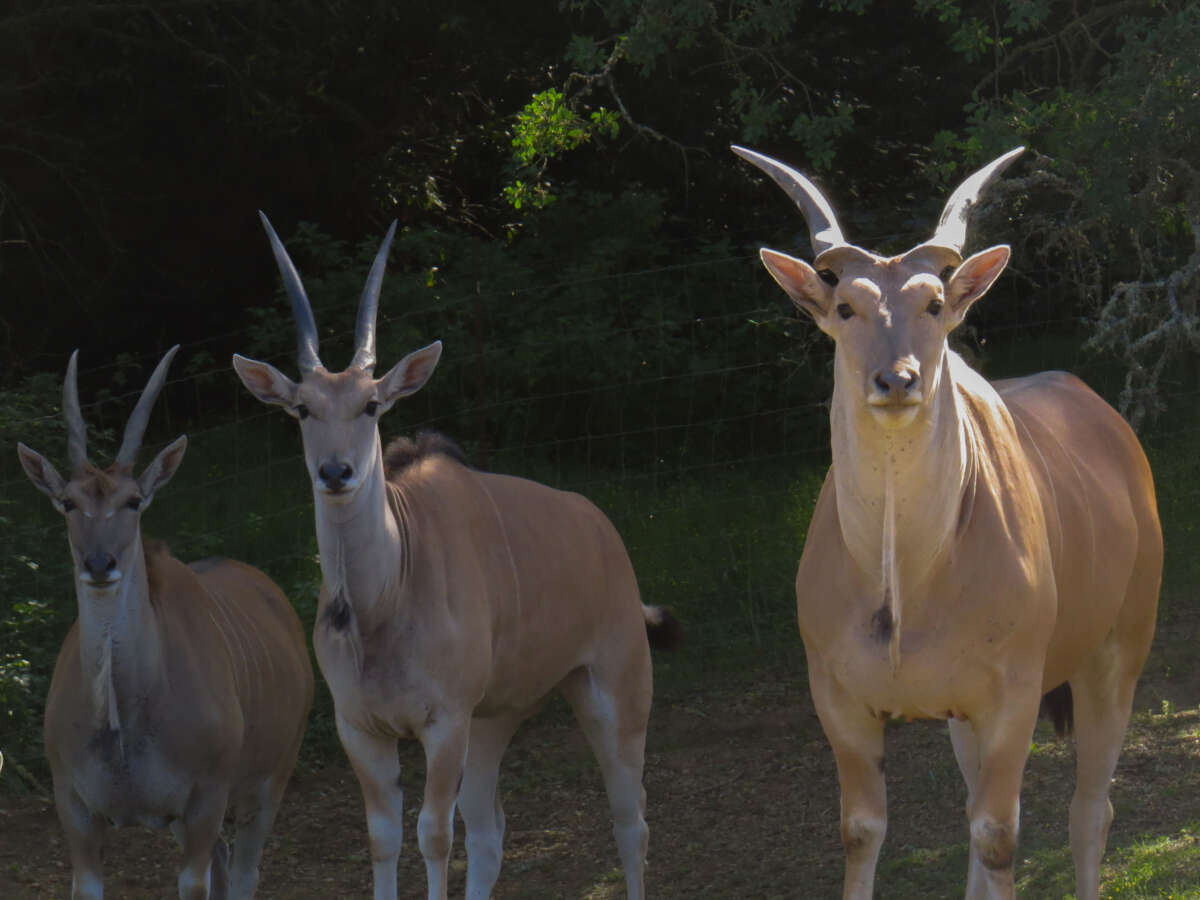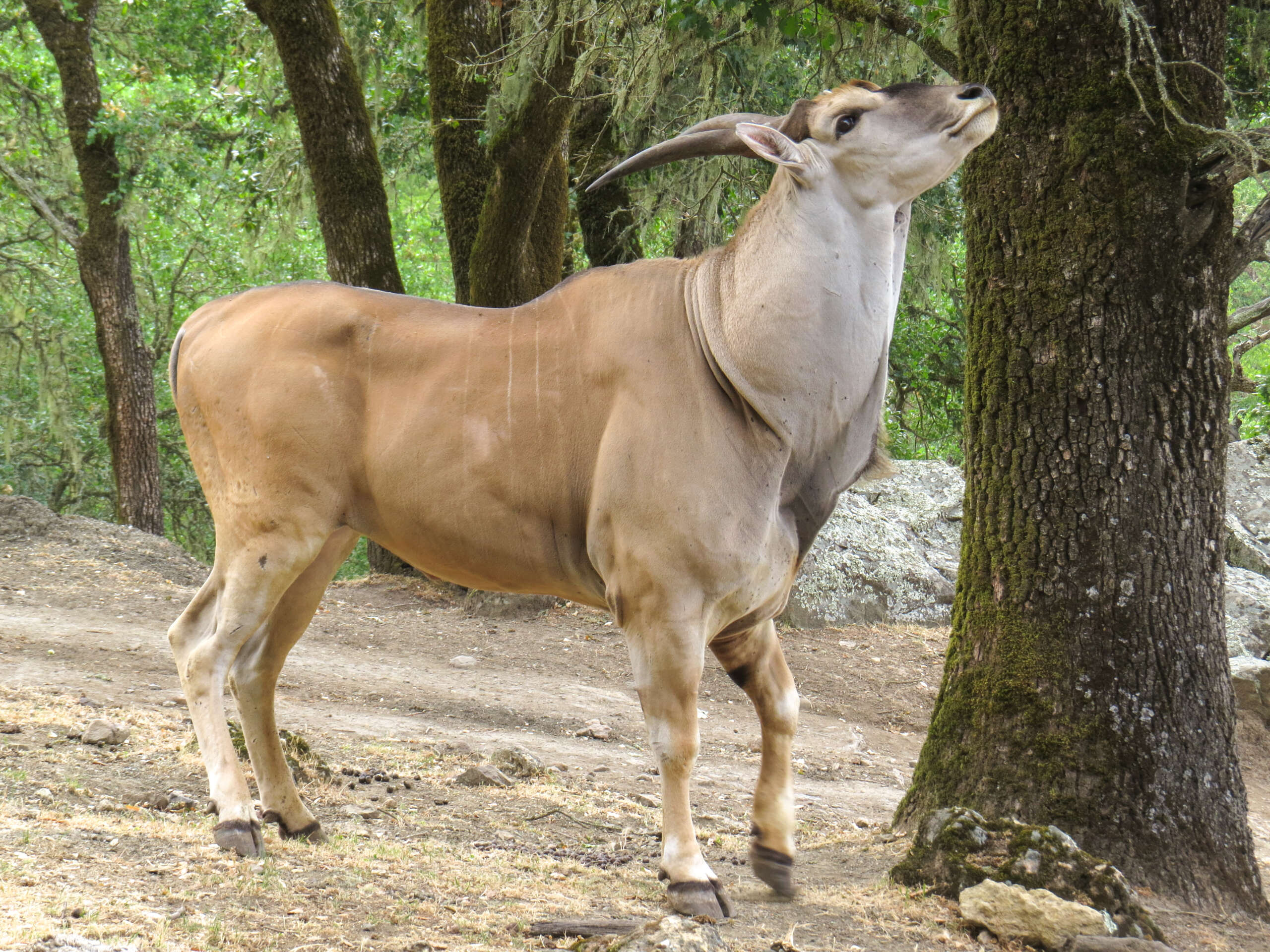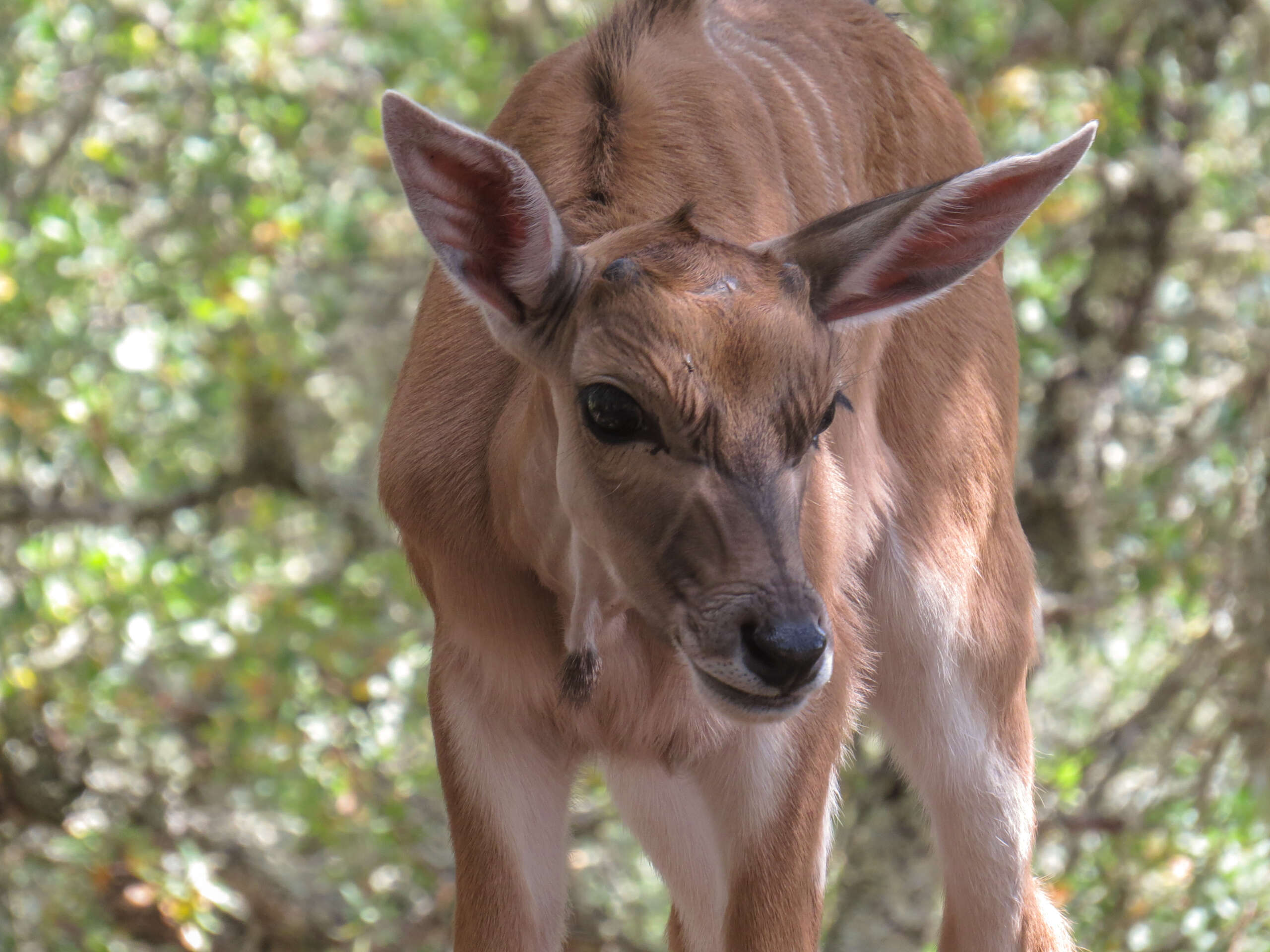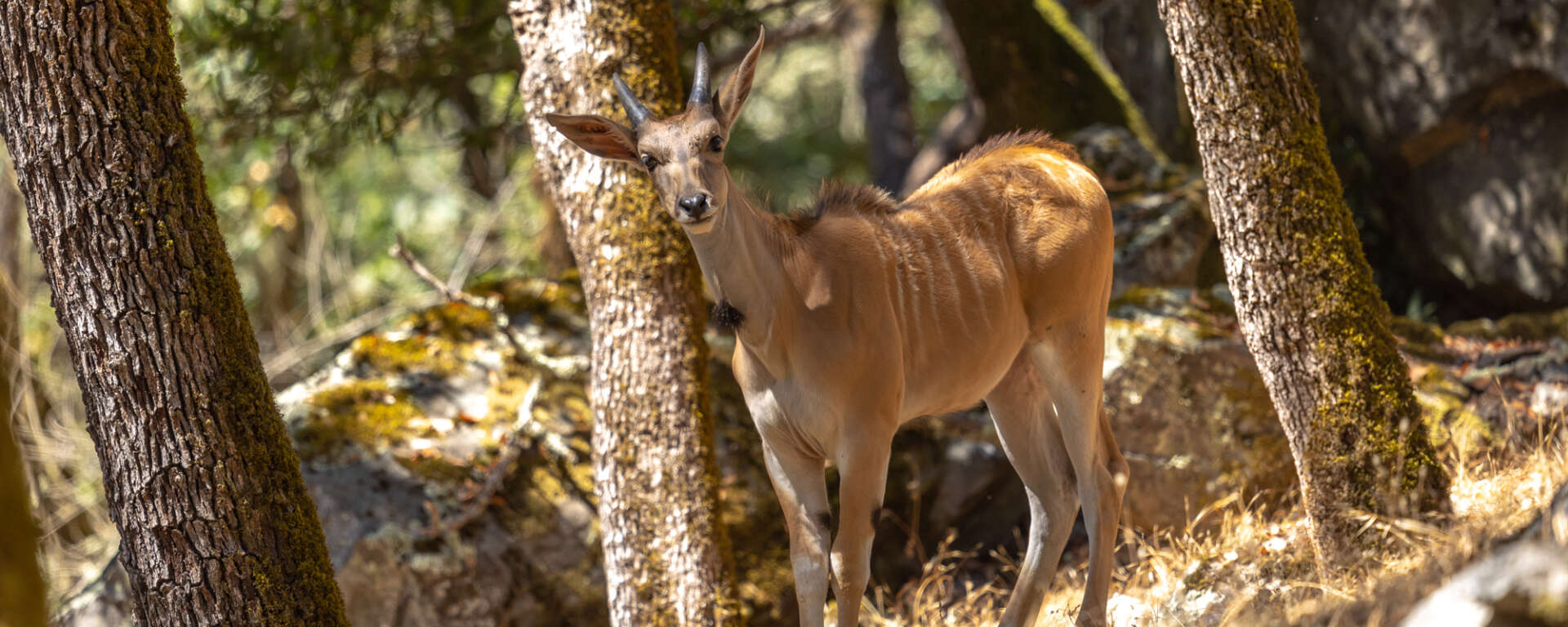Description
The common eland is an impressively large antelope. Members of the genus Taurotragus, which consists of the common eland and the giant eland, are the largest antelopes in the world in regards to body weight. This refers specifically to males—females generally weigh ~35 – 50% less than males. It is difficult to say which of these two species is the largest. According to peer-reviewed literature, the largest recorded common eland was 942 kg (2077 lbs), while the largest giant eland was 950 kg (2094 lbs). However, the literature also states that male common eland tend to be larger on average than male giant eland (the name “giant eland” refers to the massive horns on their head). In any case, the weights of these two massive antelope species overlap enough that it seems unnecessary to declare one the largest over the other.
Female and juvenile common elands have tan coats that shift to a grayish-blue in older males. Common elands have thin vertical white stripes on their flanks—this is a coat pattern seen in many antelope species of the tribe Tragelaphini that live amongst dense vegetation and in forested areas. These stripes are considered a form of disruptive camouflage, and may act to break apart the eland’s body shape in dappled shade, making them more difficult for a predator to spot.
Both male and female common eland have seemingly excess skin that hangs from their throat, called a dewlap, though the male’s dewlap is much larger. There are various hypotheses as to the function of this dewlap. It may play a role in sexual selection, aiding males in their dominance fights as they size each other up. It may dissuade predators from attacking an eland, by enlarging their profile or by acting as a signal of fitness to the predator. It may also aid in heat dissipation—more skin surface area means more space for blood vessels close to the surface to release heat, and large animals like male eland may struggle with thermoregulation. A 2016 study suggests that the heat dissipation hypothesis has the most evidence.
Both males and females have straight, twisted horns. Horns on females are thinner, longer, and less spiraled. Male eland horns can grow to 1.4 – 2.2 ft (43 – 67 cm), while female eland horns can grow to 1.7 – 2.3 ft (51 – 70 cm).
Male common elands make a characteristic clicking sound when they walk. This sound has been documented in a few other species—the reindeer, Père David’s deer, and Thorold’s deer. Although these sounds are known as “knee clicks”, anatomists have extensively investigated the source of these clicks, but their exact mechanism remains a mystery. These clicks may be a social signal during dominance displays.
Cover photo: Juvenile common eland by Mark Pressler
Classification
- Overview
- The common eland is an antelope in the Tragelaphini tribe, which are known as the spiral-horned antelope. Other members of this tribe include the kudu, nyala, and bongo.
- Class
- Mammalia
- Order
- Cetartiodactyla
- Family
- Bovidae
- Tribe
- Tragelaphini
- Genus
- Taurotragus
- Species
- T. oryx
Key Facts
- Conservation Status
- Least Concern
- Lifespan
- 15 – 20 years in the wild, up to 26 years under human care
- Height (to shoulder)
- males 4.43 – 6.00 ft (135 – 183 cm); females 4.10 – 5.02 ft (125 – 153 cm)
- Weight
- males 882 – 2077 lbs (400 – 942 kg); females 860 – 1323 lbs (390 – 600 kg)
The IUCN Red List describes the common eland as a species of Least Concern, meaning meaning conservationists around the world are not currently worried about the continuation of this species. A 1999 survey estimated the population to be ~136,000 individuals, and a 2016 evaluation estimated ~90,000 – 110,000 mature individuals. This population appears to be increasing in some areas and decreasing in others, resulting in an overall population that is currently stable.
Social Life
Common eland are typically quite social. They can be found in herds anywhere between 2 – 500+ individuals. Herds tend to be larger where food is plentiful, but group size and group members change often. Groups may be made up of mixed sexes and ages, may consist of only males, only females, or even only juveniles. Young common eland seem to often prefer the company of other juveniles over adults, and sometimes herds of up to 400 young and juveniles are seen, with no adult individuals present. Females tend to be more social than males.
Adult male eland will engage in dominance disputes, but these tend to be displays more than physical fights. Physical aggression does still occur, but typically males are able to effectively size each other up and declare a winner using a range of non-physical signaling. This includes displaying their large size by standing laterally (sideways) next to the other male, posturing their head low, shaking their head, and placing wet and sometimes urine-soaked soil and vegetation on their heads. The clicking sound made by the legs of adult male eland may also be a social signal during these dominance disputes.
Habitat and Range
Common eland are most often found in partial grasslands, shrublands, and open woodlands. They are considered extremely adaptable and are also found in a range of other habitats, including dry sub-deserts and high elevation mountainous areas. They tend to avoid true grasslands with no cover, true deserts, and dense forests and swamps. The large size of common eland helps with water conservation, so they are not as tied to standing water sources as many other antelope species. They are nomadic and have large home ranges.
Common eland are found across southern and eastern Africa south of the Congo rainforest, other than in the depths of the Kalahari and Namib deserts. Despite their large size, common eland are surprisingly agile, and one population in southern Africa is famous for its seasonal movement up and down the Drakensberg mountain range, climbing to high altitudes to sustain themselves.
Diet
Common eland will graze at the beginning of the wet season, when young grasses are readily available. The rest of the year, they browse on leaves, bushes, herbs, bark, buds, bulbs, succulent fruits and roots. They will use their horns to both pull down branches that are out of reach and dig underground for tubers. Daily activity patterns vary depending on climate—on very hot days, common eland will rest in the shade during the hottest part of the day. Otherwise, they will spend the day switching between foraging for food and resting / processing their food every few hours. Sometimes this cycle will continue deep into the night, to allow enough time to nourish their large bodies.
Predators
The male eland’s size generally discourages attacks except from predators working in collaboration. The smaller females and young eland are much more vulnerable to predators that include lions, painted dogs, leopards and spotted hyenas.
Reproduction
Sexual maturity: male 4 – 5 years, female 15 – 36 months
Mating Season: year-round
Birth Season: year-round
Gestation: 8 – 9 months
No. of Young: 1, rarely 2
- Information
-
Description
The common eland is an impressively large antelope. Members of the genus Taurotragus, which consists of the common eland and the giant eland, are the largest antelopes in the world in regards to body weight. This refers specifically to males—females generally weigh ~35 – 50% less than males. It is difficult to say which of these two species is the largest. According to peer-reviewed literature, the largest recorded common eland was 942 kg (2077 lbs), while the largest giant eland was 950 kg (2094 lbs). However, the literature also states that male common eland tend to be larger on average than male giant eland (the name “giant eland” refers to the massive horns on their head). In any case, the weights of these two massive antelope species overlap enough that it seems unnecessary to declare one the largest over the other.
Female and juvenile common elands have tan coats that shift to a grayish-blue in older males. Common elands have thin vertical white stripes on their flanks—this is a coat pattern seen in many antelope species of the tribe Tragelaphini that live amongst dense vegetation and in forested areas. These stripes are considered a form of disruptive camouflage, and may act to break apart the eland’s body shape in dappled shade, making them more difficult for a predator to spot.
Both male and female common eland have seemingly excess skin that hangs from their throat, called a dewlap, though the male’s dewlap is much larger. There are various hypotheses as to the function of this dewlap. It may play a role in sexual selection, aiding males in their dominance fights as they size each other up. It may dissuade predators from attacking an eland, by enlarging their profile or by acting as a signal of fitness to the predator. It may also aid in heat dissipation—more skin surface area means more space for blood vessels close to the surface to release heat, and large animals like male eland may struggle with thermoregulation. A 2016 study suggests that the heat dissipation hypothesis has the most evidence.
Both males and females have straight, twisted horns. Horns on females are thinner, longer, and less spiraled. Male eland horns can grow to 1.4 – 2.2 ft (43 – 67 cm), while female eland horns can grow to 1.7 – 2.3 ft (51 – 70 cm).
Male common elands make a characteristic clicking sound when they walk. This sound has been documented in a few other species—the reindeer, Père David’s deer, and Thorold’s deer. Although these sounds are known as “knee clicks”, anatomists have extensively investigated the source of these clicks, but their exact mechanism remains a mystery. These clicks may be a social signal during dominance displays.
Cover photo: Juvenile common eland by Mark Pressler
Classification
- Overview
- The common eland is an antelope in the Tragelaphini tribe, which are known as the spiral-horned antelope. Other members of this tribe include the kudu, nyala, and bongo.
- Class
- Mammalia
- Order
- Cetartiodactyla
- Family
- Bovidae
- Tribe
- Tragelaphini
- Genus
- Taurotragus
- Species
- T. oryx
Key Facts
- Conservation Status
- Least Concern
- Lifespan
- 15 – 20 years in the wild, up to 26 years under human care
- Height (to shoulder)
- males 4.43 – 6.00 ft (135 – 183 cm); females 4.10 – 5.02 ft (125 – 153 cm)
- Weight
- males 882 – 2077 lbs (400 – 942 kg); females 860 – 1323 lbs (390 – 600 kg)
- Conservation
The IUCN Red List describes the common eland as a species of Least Concern, meaning meaning conservationists around the world are not currently worried about the continuation of this species. A 1999 survey estimated the population to be ~136,000 individuals, and a 2016 evaluation estimated ~90,000 – 110,000 mature individuals. This population appears to be increasing in some areas and decreasing in others, resulting in an overall population that is currently stable.
- Lifestyle
Social Life
Common eland are typically quite social. They can be found in herds anywhere between 2 – 500+ individuals. Herds tend to be larger where food is plentiful, but group size and group members change often. Groups may be made up of mixed sexes and ages, may consist of only males, only females, or even only juveniles. Young common eland seem to often prefer the company of other juveniles over adults, and sometimes herds of up to 400 young and juveniles are seen, with no adult individuals present. Females tend to be more social than males.Adult male eland will engage in dominance disputes, but these tend to be displays more than physical fights. Physical aggression does still occur, but typically males are able to effectively size each other up and declare a winner using a range of non-physical signaling. This includes displaying their large size by standing laterally (sideways) next to the other male, posturing their head low, shaking their head, and placing wet and sometimes urine-soaked soil and vegetation on their heads. The clicking sound made by the legs of adult male eland may also be a social signal during these dominance disputes.
Habitat and Range
Common eland are most often found in partial grasslands, shrublands, and open woodlands. They are considered extremely adaptable and are also found in a range of other habitats, including dry sub-deserts and high elevation mountainous areas. They tend to avoid true grasslands with no cover, true deserts, and dense forests and swamps. The large size of common eland helps with water conservation, so they are not as tied to standing water sources as many other antelope species. They are nomadic and have large home ranges.Common eland are found across southern and eastern Africa south of the Congo rainforest, other than in the depths of the Kalahari and Namib deserts. Despite their large size, common eland are surprisingly agile, and one population in southern Africa is famous for its seasonal movement up and down the Drakensberg mountain range, climbing to high altitudes to sustain themselves.
Diet
Common eland will graze at the beginning of the wet season, when young grasses are readily available. The rest of the year, they browse on leaves, bushes, herbs, bark, buds, bulbs, succulent fruits and roots. They will use their horns to both pull down branches that are out of reach and dig underground for tubers. Daily activity patterns vary depending on climate—on very hot days, common eland will rest in the shade during the hottest part of the day. Otherwise, they will spend the day switching between foraging for food and resting / processing their food every few hours. Sometimes this cycle will continue deep into the night, to allow enough time to nourish their large bodies.Predators
The male eland’s size generally discourages attacks except from predators working in collaboration. The smaller females and young eland are much more vulnerable to predators that include lions, painted dogs, leopards and spotted hyenas.Reproduction
Sexual maturity: male 4 – 5 years, female 15 – 36 months
Mating Season: year-round
Birth Season: year-round
Gestation: 8 – 9 months
No. of Young: 1, rarely 2

Adult male and female common elands by Mark Pressler

Adult male common eland by Mark Pressler

Young common eland by Mark Pressler

